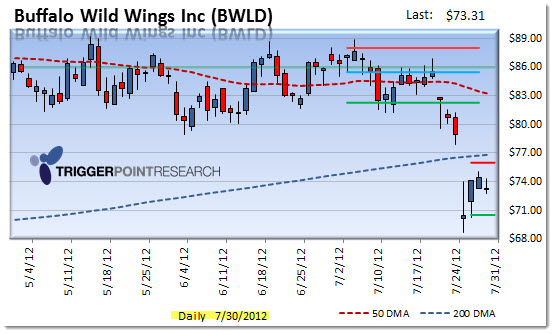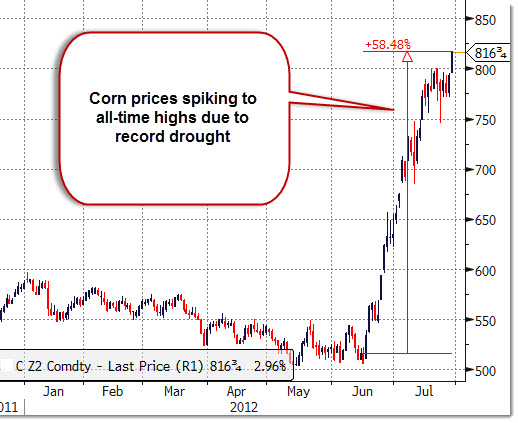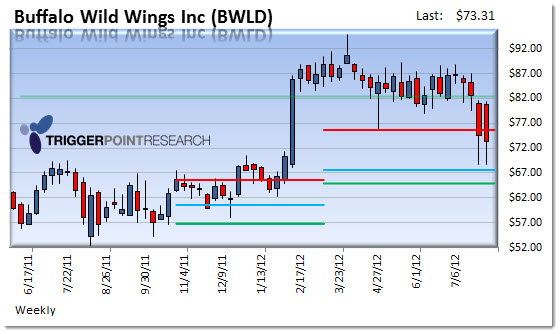For some time we have been concerned that the high cost of corn would cause problems for restaurants. From meat to poultry, the record corn prices brought on by record droughts are having an adverse effect on margins for chains like Buffalo Wild Wings (BWLD) and Chipotle Mexican Grill (CMG).
BWLD has been a high flier (pun?) that has been a favorite of growth investors. But, to a point the stock has been defying gravity. Growth has slowed and the warnings by management last quarter about their concern over increasing costs were largely ignored by investors. Just last week, the company provided a luke-warm earnings report and outlook that confirmed that management was not kidding a few months ago. While they plan on raising menu prices, it comes at a time that consumers are spending less and confidence is waning.
Fundamentally, this is a name that is now broken as a growth stocks since margins have compressed and EPG growth has slowed.
Technically, there is a hole that we have identified that extends down to $64.50.
On a daily basis, notice that there is limited support down to $70 and then another close to $69.90. If it breaks that, it could move down to $64/$65.
Since June 18th, Corn futures have launched 58% higher. As this is one of the main feed products for chickens, it has caused a similar price move for poultry. In the latest report we see that parts (wings etc.) have seen a 75% to 85% move in the last few months.
A look at weekly the chart:
An ALERT! was triggered today – see the details on Triggerpoint Research .
The chickens have come home to roost at Buffalo Wild Wings, a casual-dining chain whose second-quarter earnings were pecked by a sharp rise in chicken-wing prices. Earnings in coming quarters also could feel the negative effect of higher input prices, leading to further losses in the company’s shares.
Barron’s warned last winter (in “Time to Play Chicken With Wings,” Feb. 6) that rising wing prices would clip Buffalo’s results and stock price, but these developments took longer than expected to hatch. The shares (ticker: BWLD) zoomed about 31%, to a peak of $94.81 in the eight weeks after our story appeared, leaving us covered with egg but convinced our thesis was valid.
Chicken wings could hit $2 a pound at the wholesale level in 2013, causing more pain for Buffalo. The company is raising menu prices and running ads for burgers.
Sure enough, Buffalo reported last Wednesday that second-quarter earnings rose only 7% at its 837-unit chain of sports-bar-themed restaurants. The disappointing results, some six cents shy of Wall Street’s consensus estimate, came despite a 30% increase in revenue in the period, to $239 million. The Minneapolis-based company was hurt by lower-than-expected sales growth of 5.3% at stores open at least a year, a higher share count, and an 86% surge in chicken-wing prices from the year-ago quarter. Buffalo lowered its 2012 earnings-growth target to 15% to 20% from the previous 20%, citing commodity pressures.
The shares, meanwhile, gapped down at Wednesday’s open and finished the week off 10% at $74.42, just 5% above where they traded when our story appeared. The stock remains pricey at almost 20 times next year’s earnings forecast of $3.77 a share, and could drop to the low $60s if wing prices continue to crimp profit margins.
[image]
CHICKEN-WING PRICES typically rise heading into the Super Bowl, boosted by heavy demand among game-watchers for the finger-lickin’ snacks. This year, however, prices failed to retreat after the big game, as chicken producers, focused on profitability, cut the number of chicks hatched. More recently, prices have been kept aloft by a severe drought in the Midwest, which is expected to reduce the corn harvest, raising the price of chicken feed. Producers again are likely to reduce the number of chickens raised, hoping for higher prices to offset rising costs.
Wing prices averaged 88 cents per pound in June 2011, but jumped to $1.09 last September, $1.51 in December and $1.80 last month. Buffalo Wild Wings’ cost of sales at restaurants climbed to 31.6% of revenue in the latest quarter, up from 27.2% last year. The company expects third-quarter wing prices to average $1.95 a pound, up 70% year over year.
Next year, prices could average $2 per pound. If they drop below $1.80, producers may opt to put wings into freezers to reduce supply and keep prices aloft, says William Roenigk, chief economist at the National Chicken Council. He expects to see production cuts in the fourth quarter, and thinks prices will retreat in 2014 only if there is an abundant corn crop.
Howard Penney, an analyst at Hedgeye Risk Management, still sees risk in Buffalo’s stock, and thinks Wall Street underestimates the staying power of higher wing prices. He has a $62 target price on the shares, and expects the company to earn $3.39 in 2013.
BUFFALO MANAGEMENT REMAINS upbeat on the company’s outlook, despite last week’s bad news. “We are committed to being a high-growth company,” CEO Sally Smith says.
At the least, Buffalo will be bigger soon. The company, which operates in the U.S. and Canada, plans to open 100 to 110 company-owned and franchised stores this year, up from 85 last year. In addition, it has entered franchise agreements in the Middle East and Puerto Rico.
The Bottom Line
Buffalo Wild Wings shares fell 10% last week to $74.42, and could retreat to the low-$60s if wing prices remain elevated, as expected.
To offset higher wing prices, Buffalo is raising prices 3% in the third quarter and 4% in the fourth. It will promote other menu items in ads, including boneless “wings” and hamburgers, and might change the way it sells wings, scrapping by-the-wing orders for orders of multiple pieces sold by weight. Doing so would align its purchasing practices with sales.
But until Wall Street appreciates the drag higher wing prices could have on earnings, the shares could have more stomach-churning days



















